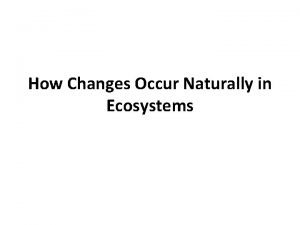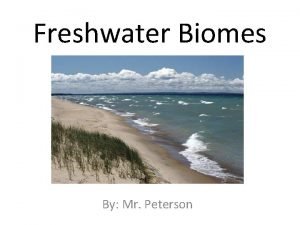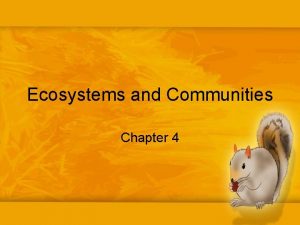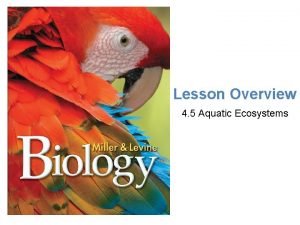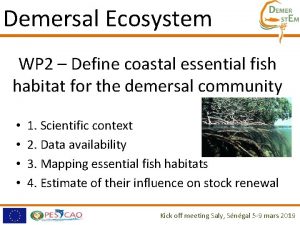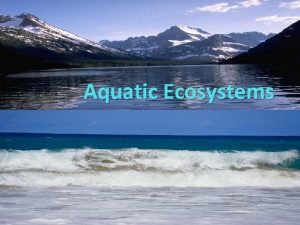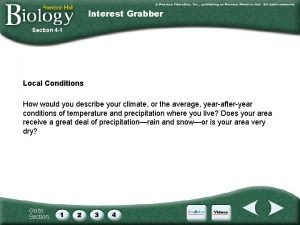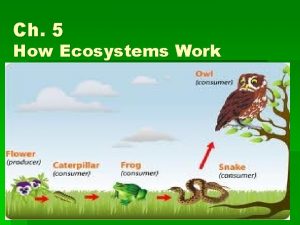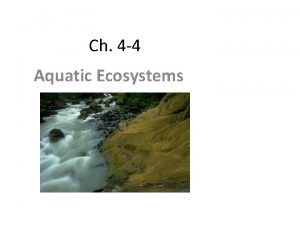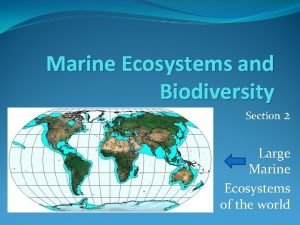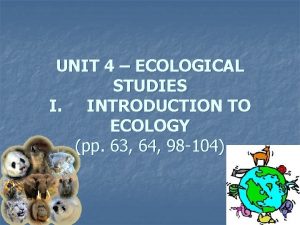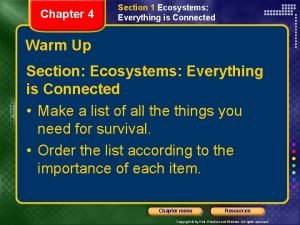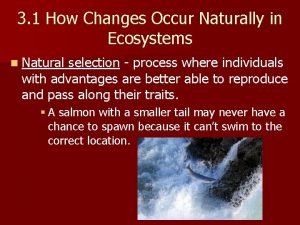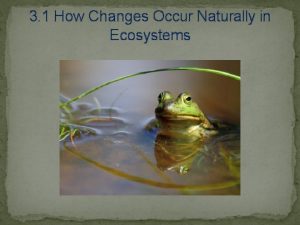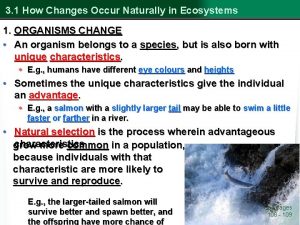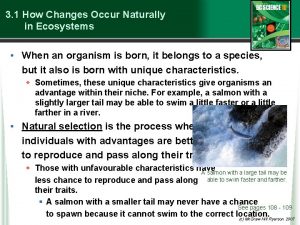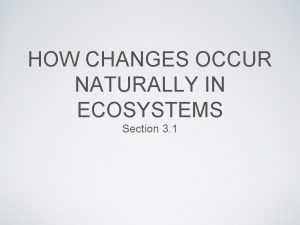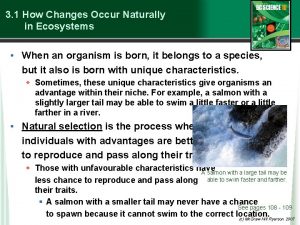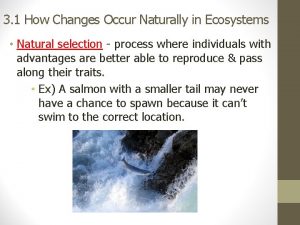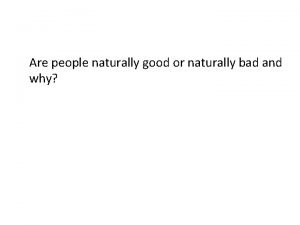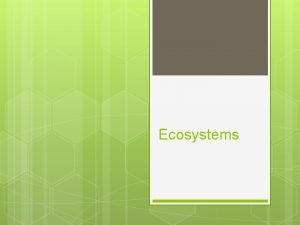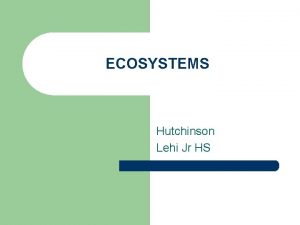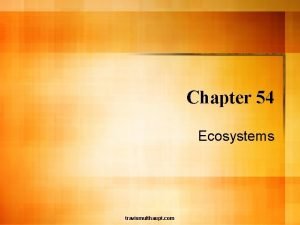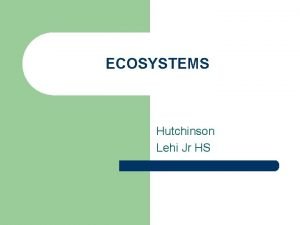How Changes Occur Naturally in Ecosystems How do




















- Slides: 20

How Changes Occur Naturally in Ecosystems

How do organisms adapt to change? • In natural selection, the best-adapted members of a species survive to reproduce. • These individuals may pass favourable characteristics on to their offspring. • As abiotic and biotic components of their environment change, adaptive radiation may result. This term describes the change from a common ancestor into a number of different species that “radiate out” to inhabit different niches. • For example, 13 species of finches that fill different niches on the Galapagos Islands are thought to have developed from a single species from mainland South America.




How do ecosystems change over time? • Ecological succession refers to changes that take place over time in the types of organisms that live in an area. There are two types of ecological succession: • Primary Succession • Secondary Succession

Primary Succession • Primary succession: Primary succession occurs in areas where no soil exists, such as following glaciation or a lava flow. • Wind and rain carry spores of lichens to these areas. • Lichens obtain nutrients by secreting chemicals that break down rock. As lichens decay, they add organic matter to the developing soil. • The first organisms to survive and reproduce in an area are called pioneer species. They are adapted to grow in harsh, nutrient-poor conditions. • In time, often over hundreds of years, the weathering of rocks and decay of pioneer species cause soil formation. • The abiotic conditions of the ecosystem continue to change as new species of plants and animals colonize the area, each competing for nutrients, moisture, and sunlight. • More niches are created and biodiversity increases. • Eventually, primary succession leads to the development of mature climax communities, such as a boreal forest or grassland


Secondary Succession • Secondary succession: Small disturbances, such a fire, • often occur in ecosystems. • Secondary succession—succession that occurs as a result of a disturbance to an area that already has soil and was once the home of living organisms—occurs as a result. • It proceeds much faster than primary succession since micro-organisms, insects, seeds, and nutrients still exist in the soil.


How do natural events affect ecosystems? • Natural events can destroy habitats, reduce biodiversity, and cause regions to undergo succession. Some examples include: • flooding: results in soil erosion, pollution, and disease when toxins or harmful bacteria from untreated sewage enter drinking water • drought: plants and animals die due to lack of water • insect infestations: often result in succession in forests • because insects destroy older, weaker trees • tsunamis: huge, rapidly moving ocean waves destroy habitats and salt water carried onto shore changes soil composition

How Humans Influence Ecosystems

How does land resource use affect sustainability? • Sustainability refers to the ability of an ecosystem to sustain ecological processes. • Land use refers to the ways we use the land around us—for cities, roads, industry, agriculture, and recreation. • Resource use refers to the ways we obtain and use resources—naturally occurring materials, such as soil, wood, water, and minerals. Resource use is also referred to as resource exploitation. • One example of resource use affecting sustainability is deforestation in China. The result is that less bamboo is available as food for China’s giant pandas. • In another example, whaling in the Pacific Ocean decreased numbers of whales—the orcas’ primary food source. Orcas turned to eating other prey, such as sea otters. But sea otters eat sea urchins and when the numbers of sea otters went down, the numbers of sea urchins exploded.

How can First Nations’ knowledge improve resource management? • First Nations’ thorough understanding of the plants, animals, and natural occurrences in their environment is referred to as traditional ecological knowledge. It reflects knowledge— about local climate and resources, biotic and abiotic characteristics, and animal and plant life cycles—that was gained over centuries. • It provides researchers with valuable data with regard to management practices that enhance the productivity and health of ecosystems.

How can resource exploitation affect ecosystems?

How Introduced Species Affect Ecosystems

How can introduced species affect an ecosystem? • Native species are plants and animals that naturally inhabit an area. Introduced species or foreign species are species that have been introduced into an ecosystem by humans, either intentionally or accidentally. They do not naturally inhabit the ecosystem. • Introduced species are usually beneficial or harmless. • However, some introduced species, known as invasive species, can dramatically change or destroy ecosystems. • With climate change and the expansion of international trade and travel, invasive species are entering new ecosystems at an increasing rate. • This rapid spread of introduced invasive species is a major cause of global • biodiversity loss. • Introduced species can affect native species through competition, predation, disease, parasitism, and habitat alteration, as shown in the table on the next page.

Examples of the effects of introduced species include: • Scotch broom was introduced to British Columbia as a garden plant. It has up to 18 000 seeds per plant, can survive drought, and fixes nitrogen in the soil, causing conditions that many native species have trouble growing in. Together with other introduced species, it is competing with the keystone species Garry oak on Vancouver Island. • European starlings outcompete native birds for nesting sites, and cause decreases in their populations. Barn owls are able to keep the numbers of starlings low in some areas.

• Eurasian milfoil forms mats on the surface of waterways that decrease the amount of sunlight available to organisms lower down. It is spread by boat traffic since it can regrow from small pieces. • Norway rats eat a wide variety of foods, including preying on native species. • Blister rust grows on the native whitebark pine, causing disease that kills the trees. • Wild boars are considered one of the world’s worst invasive species. Their behaviours spread weeds and interfere with natural succession, and they prey on native species. • Purple loosetrife is an introduced species, and the introduced loosestrife-eating beetle is proving to be a good way to control its spread.

 How do ecosystems change naturally
How do ecosystems change naturally Elizabeth mulroney
Elizabeth mulroney Physicl change
Physicl change Chapter 42 ecosystems and energy
Chapter 42 ecosystems and energy Section 3 aquatic ecosystems worksheet answers
Section 3 aquatic ecosystems worksheet answers Freshwater biomes facts
Freshwater biomes facts Ecosystems and communities chapter 4 answer key
Ecosystems and communities chapter 4 answer key Photic and aphotic zones
Photic and aphotic zones Define demersal
Define demersal Describe freshwater
Describe freshwater Section 4-4 aquatic ecosystems
Section 4-4 aquatic ecosystems Forest food chain
Forest food chain How ecosystems work
How ecosystems work 4-4 aquatic ecosystems
4-4 aquatic ecosystems Biodiversity
Biodiversity Differences between aquatic and terrestrial ecosystems
Differences between aquatic and terrestrial ecosystems Ecosystems interactions
Ecosystems interactions The chaparral biome is best characterized by _______.
The chaparral biome is best characterized by _______. Introduction of river pollution
Introduction of river pollution Ecosystem title page
Ecosystem title page Chapter 4 section 1: ecosystems: everything is connected
Chapter 4 section 1: ecosystems: everything is connected
